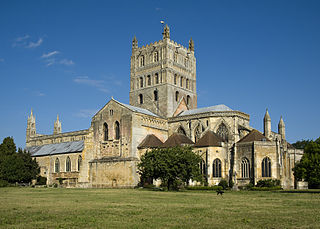
The Abbey Church of St Mary the Virgin, Tewkesbury–commonly known as Tewkesbury Abbey–is located in the English county of Gloucestershire. A former Benedictine monastery, it is now a parish church. Considered one of the finest examples of Norman architecture in Britain, it has the largest Romanesque crossing tower in Europe.

Gilbert de Clare, 6th Earl of Hertford, 7th Earl of Gloucester was a powerful English noble. He was also known as "Red" Gilbert de Clare or "The Red Earl", probably because of his hair colour or fiery temper in battle. He held the Lordship of Glamorgan which was one of the most powerful and wealthy of the Welsh Marcher Lordships as well as over 200 English manors.
The title of Earl of Gloucester was created several times in the Peerage of England. A fictional earl is also a character in William Shakespeare's play King Lear.
Earl of Clare was a title of British nobility created three times: once each in the peerages of England, Great Britain and Ireland.
In English law, the justices in eyre were the highest magistrates, and presided over the court of justice-seat, a triennial court held to punish offenders against the forest law and enquire into the state of the forest and its officers.

Eleanor de Clare, suo jure 6th Lady of Glamorgan was a Anglo-Welsh noblewoman who married Hugh Despenser the Younger and was a granddaughter of Edward I of England. With her sisters, Elizabeth de Clare and Margaret de Clare, she inherited her father's estates after the death of her brother, Gilbert de Clare, 8th Earl of Gloucester, 7th Earl of Hereford at the Battle of Bannockburn in 1314. She was born in 1292 at Caerphilly Castle in Glamorgan, Wales and was the eldest daughter of Gilbert de Clare, 6th Earl of Hertford, 7th Earl of Gloucester, 5th Lord of Glamorgan and Princess Joan of Acre.

Thomas le Despenser, 2nd Baron Despenser, 1st Earl of Gloucester KG was the son of Edward le Despenser, 1st Baron le Despencer, whom he succeeded in 1375.

The House of Clare was a prominent Anglo-Norman noble house that held at various times the earldoms of Pembroke, Hertford and Gloucester in England and Wales, as well as playing a prominent role in the Norman invasion of Ireland.
Gilbert de Clare, 8th Earl of Gloucester, 7th Earl of Hertford was an English nobleman and military commander in the Scottish Wars. In contrast to most English earls at the time, his main focus lay in the pursuit of war rather than in domestic political strife. He was the son of Gilbert de Clare, 7th Earl of Gloucester, and Joan of Acre, daughter of King Edward I. The older Gilbert died when his son was only four years old, and the younger Gilbert was invested with his earldoms at the young age of sixteen. Almost immediately, he became involved in the defence of the northern border, but later he was drawn into the struggles between Edward II and some of his barons. He was one of the Lords Ordainers who ordered the expulsion of the king's favourite Piers Gaveston in 1311. When Gaveston was killed on his return in 1312, Gloucester helped negotiate a settlement between the perpetrators and the king.

Richard de Beauchamp, Earl of Worcester, KB was an English peer.

William de Beauchamp, 1st Baron Bergavenny, KG was an English peer.

Ralph de Monthermer, 1st Baron Monthermer, Earl of Gloucester, Hertford, and Atholl was an English nobleman, who was the son-in-law of King Edward I. His clandestine marriage to the King's widowed daughter Joan greatly offended her father, but he was quickly persuaded to pardon Ralph.
This article is about the particular significance of the century 1301–1400 to Wales and its people.
Alice de Toeni, Countess of Warwick was a wealthy English heiress and the second wife of Guy de Beauchamp, 10th Earl of Warwick, an English nobleman in the reign of kings Edward I and Edward II. He was one of the principal opponents of Piers Gaveston, a favourite of Edward II. Alice married three times; Guy was her second husband.
Isabella de Beauchamp, Lady Kidwelly, Baroness Despenser, was an English noblewoman and wealthy heiress.
Mary MacDuff, Countess of Fife was an English noblewoman. She was a daughter of Ralph de Monthermer, 1st Baron Monthermer and his wife Joan of Acre. Other sources have her being born in 1298.
The feudal barony of Gloucester or Honour of Gloucester was one of the largest of the mediaeval English feudal baronies in 1166, comprising 279 knight's fees, or manors. The constituent landholdings were spread over many counties. The location of the caput at Gloucester is not certain as Gloucester Castle appears to have been a royal castle, but it is known that the baronial court was held at Bristol in Gloucestershire.








